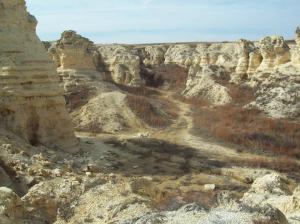out of sequence fossils
“Oceans of Kansas,” Unexpected Fossils, and Young Earth Creationism
 Recently, I reviewed the debate between Bill Nye and Ken Ham. In that debate, Bill Nye challenged Ken Ham to come up with just one fossil that was in the wrong place in the fossil sequence. In that review, I mentioned polystrate fossils as one possibility for the YEC rejoinder. Strictly speaking, these fossils are not “out of sequence” in a formal sense and so do not qualify as such evidence. Are there other possibilities? Michael J. Everhart’s fascinating look at the natural history of the Western Interior Sea brings up another possibility which may draw some looking for out-of-sequence fossils. After an introductory narrative about how a mosasaur (pictured on the cover of the book getting chomped by a shark) fossil could end up broken up in the middle of the sea, he wrote:
Recently, I reviewed the debate between Bill Nye and Ken Ham. In that debate, Bill Nye challenged Ken Ham to come up with just one fossil that was in the wrong place in the fossil sequence. In that review, I mentioned polystrate fossils as one possibility for the YEC rejoinder. Strictly speaking, these fossils are not “out of sequence” in a formal sense and so do not qualify as such evidence. Are there other possibilities? Michael J. Everhart’s fascinating look at the natural history of the Western Interior Sea brings up another possibility which may draw some looking for out-of-sequence fossils. After an introductory narrative about how a mosasaur (pictured on the cover of the book getting chomped by a shark) fossil could end up broken up in the middle of the sea, he wrote:
“Bloating and Floating” is certainly the case in many instances and is the only reasonable explanation for how the remains of large dinosaurs, such as Niobrarasaurus coleii…could have found their way into the middle of the Western Interior Sea… (48)
There have been, he noted, discoveries of dinosaurs in the middle of what should have been fossils of only aquatic creatures in the chalk and limestone that covers much of the central states–what was in ancient times the Western Interior Sea. His proposed explanation is that a dinosaur might die on the shore and get swept out to sea, bloated and floating until coming to rest at the bottom and becoming fossilized. Though not necessarily the “only reasonable” explanation, Everhart’s scenario provides an interesting test case for rival hypotheses.
Young Earth Creationists (YECs) tend to view evidences like these as proof of the Flood. That is, given a catastrophic global flood, one would expect that different life forms, all killed together by the flooding of the whole Earth, would be mixed together. Thus, a dinosaur in the middle of what should be sea creatures is alleged to provide evidence for the YEC Flood hypothesis.However, Everhart’s scenario does seem to be more plausible than a young earth account for several reasons.
First, Everhart’s proposed scenario is much simpler an explanation than the hypothesis that a global flood swept the dinosaur(s) into the position they are found among so many aquatic remains. This point is not to be understated; on a purely historical level, without any a priori assumptions of what should be the case given a specific reading of Genesis, it seems more reasonable to suppose that a dinosaur died and had its carcass swept out to sea before it was scavenged and sank to the bottom of the sea to be deposited than to suppose that a global catastrophe led to the dinosaur being found in its present location.

A picture I took at “Castle Rock” in central Kansas. This beautiful formation has huge amounts of deposited limestone and shells layered atop each other. One can walk to the walls and literally pull slabs of fossils out of the sides. If the YEC account of the flood were correct, one would expect to find multiple varieties of creatures found throughout these layers.
Second, and perhaps more problematic for the YEC position, is the fact that such finds as these are extremely rare, when, given a global flood, the expectation should be to constantly find such mixing of types of fossils. Simply finding one dinosaur fossil (or even several) among countless numbers of mosasaurs, icthyosaurs, fish, and of course limestone deposits from sea life (alongside shells of all sorts of varieties, etc.) does not actually provide sufficient evidence for the YEC account of the flood. We should instead find primates, dinosaurs, mosasaurs, trilobites, mammoths, and archaeopteryx fossils jumbled together. What we do find is a stunning uniformity of fossils such that the find of a dinosaur is means for speculation regarding how it got there rather than a commonality which demonstrates a planetwide flood.
Third, the dinosaur in question was contemporaneous with the aquatic life. That is, it lived at the same time as the creatures in the chalk in which it was deposited. Again, on a YEC scenario, one would expect instead to find all sorts of mixing of fossils from different time periods. The fact that these dinosaurs lived on land in the same time in which we find them at the bottom of the sea does not suggest a massive global flood which mixed all life (which all lived at the same time) together in one death pool; instead, it counts as direct evidence for the gradual diversification and extinction of life. The finds are consistent with what one would expect with longer periods of time instead of a global flood. Thus, it does not seem that fossils found in unexpected places may serve as evidence for Young Earth Creationism. Indeed, given the second point in particular (and in conjunction with the third), it seems that they serve as yet another evidence against the notion of a young earth and global flood. There are better options for Christians than Young Earth Creationism.
Links
Be sure to check out the page for this site on Facebook and Twitter for discussion of posts, links to other pages of interest, random talk about theology/philosophy/apologetics/movies and more!
What options are there in the origins debate? – A Taxonomy of Christian Origins Positions– I clarify the breadth of options available for Christians who want to interact on various levels with models of origins. I think this post is extremely important because it gives readers a chance to see the various positions explained briefly.
Shells and the Biomass of Earth: A serious problem for young earth creationists– I argue that the sheer amount of living organisms we can discover weighs against a young earth position.
My thanks to fellow blogger “The Natural Historian” for some comments on the topic of this post prior to publication.
Source
Michael J. Everhart, Oceans of Kansas: A Natural History of the Western Interior Sea (Indiana University Press, 2005).
SDG.
——
The preceding post is the property of J.W. Wartick (apart from quotations, which are the property of their respective owners, and works of art as credited; images are often freely available to the public and J.W. Wartick makes no claims of owning rights to the images unless he makes that explicit) and should not be reproduced in part or in whole without the expressed consent of the author. All content on this site is the property of J.W. Wartick and is made available for individual and personal usage. If you cite from these documents, whether for personal or professional purposes, please give appropriate citation with both the name of the author (J.W. Wartick) and a link to the original URL. If you’d like to repost a post, you may do so, provided you show less than half of the original post on your own site and link to the original post for the rest. You must also appropriately cite the post as noted above. This blog is protected by Creative Commons licensing. By viewing any part of this site, you are agreeing to this usage policy.
